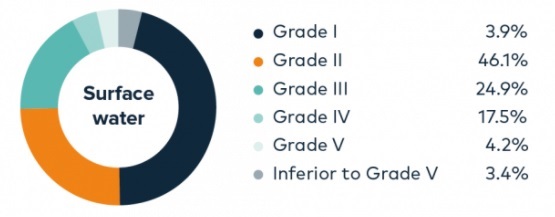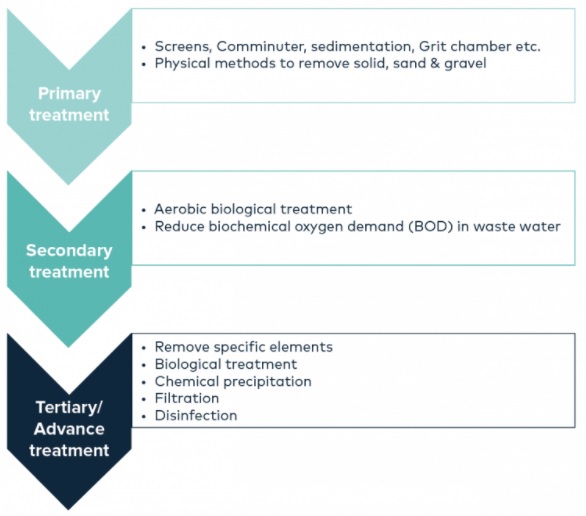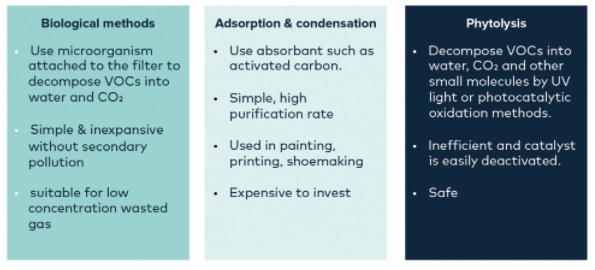In recent years, environmental pollution has caused widespread concern and adverse health effects. The Chinese government has since started addressing climate and environmental issues, particularly related to air and water quality. At the national Conference on Ecology and Environmental Protection, President Xi Jinping indicated that China would battle against pollution and develop an ecological civilization1. With the stated goal of controlling pollution and reversing environmental problems, there are now commercial opportunities to join in the efforts to protect the environment.
Environmental challenges: Water & Air
By 2019, 53.4% of all cities still failed to meet the national air quality standards. The standards set by the national-level government are meant to ensure the health and safety of citizens. Chronic exposure to major pollutants like particles including PM2.5, O3 (surface ozone a pollutant, not to be confused with "ozone hole" in Antarctica), and NOx in cities can cause a variety of health concerns, detrimental to the ecosystems such as acid rain and reduce yield in crops. Small particles like PM2.5 can bypass natural defences of the respiratory system and penetrate deep into the lungs where they cause serious damages. When O3 is breathed in, it irritates lung and throat, and tighten up airways causing difficulty in breathing and respiratory distress. Control and prevention of ozone pollution are much-complicated processes as it is not directly emitted and is instead formed from other pollutants. In short, reducing volatile organic compounds (VOCs) emission is the key to control ozone pollution in cities.
China has 20% of the world's population, but it only has 7% of global water resources. Constant floods, drought, contamination, and uneven distribution resulted in water scarcity and poor water quality in many regions. Poor water quality poses a great health risk and reduces the already limited freshwater resource. The wastewater reuse rate is currently only 15.98%. In terms of water quality, chemical oxygen demand (COD) and total phosphorus (TP) are key indicators. COD can effectively determine pollutants level in water, and TP used as an indicator to prevent eutrophication (algal boom) in freshwater. Eutrophication rapidly deprives oxygen in water and therefore kills many aquatic animals. Preventing eutrophication and meeting the demand of urbanization, the wastewater treatment industry has boomed. Hence, this article will introduce detailed VOCs and wastewater treatment developments in China.
Environmental protection and regulation in China
The Ministry of Ecology and Environment (MEE), an integral department of the State Council, is the regulatory body that oversees ecological and environmental protection. Since 2012, China has invested RMB 3.7 trillion into battling pollution. The central government has demonstrated efforts in environmental welfare through their legislative changes. The new Environmental protection law effective from 2015 has expanded from 47 to 70 articles, which prioritized environmental protection over development and granted public access to information in environmental protection. Illicit activities, under the new law, will face fines with no maximum amount. Besides Environmental protection law, Water Pollution Prevention & Control Law regulates urban, as well as Agriculture and Rural areas water treatment and release. Moreover, in 2015, the state department released Action Plan for Prevention & Control Water Pollution aiming to improve water quality in the major river basin and urban area. The plan has ensured wide coverage of sewage network across countries and a minimum 95% and 85% treatment rate in urban and countries, respectively. The action plan is also seeking to upgrade facilities, recycle, regenerate industrial water, halt heavy industrial contamination, and prevent livestock farming pollution. In June 2018, MEE issued Action Plan on Winning the battle for the blue sky set goals of joint control of Greenhouse Gas (GHG) emissions while promoting air pollution control. A year later, the Comprehensive Control Plan for Volatile Organic Compounds (VOCs) in Key Industries issued by the MEE brought attention to VOC emission issues. China is now a huge market for industrial solutions to limit VOC emission from its diverse sources.
Perspective based on China's Five-Year Plans
Since the 12th Five-year plan (FYP), the Chinese government emphasized the importance of the development of the wastewater treatment industry. The new 14th FYP was released in 2021 and continued to focus on developing this industry. Besides the well-known goal of becoming carbon-neutral, environmental quality control remains a top priority in environmental governance. Like the 12th and 13th FYP, sewage treatment, emission reduction, and energy transition remain in the central framework. Noticeably, 14th FYP has included ozone pollution. The new PM2.5 and O3 coordinated control plan aimed to achieve a 10% reduction in PM2.5 in the urban area and a 10% reduction in ozone precursor gases (NOx and VOCs). Since the 13th FYP accomplished most of the goals related to transitioning the energy sector, the new plan will cover more sectors. Even though VOCs are not as infamous as PM2.5, they have the most business potential due to worsening ozone pollution in China and high demand from various industries.

Figure 1 from 2019 Report on the State of the Ecology and
Environment in China. Inferior to Grade V has no useful function
except adjusting of the local climate.
Concerning water pollution control, although the previous 13th FYP set a goal for all water to meet the Grade V standard of agriculture and landscape irrigation, 3.4% of total surface water was still below this grade in 2019. Intending to improve water quality, the 14th FYP hopes to eliminate all these inferior bodies of water and set a new goal of an 8% reduction in Chemical Oxygen Demand (COD), ammonia, and nitrogen emission. To meet these goals, it all comes down to water treatment.
Wastewater treatment
There are three stages in wastewater treatment: primary, secondary, and advanced treatments. In the primary stage, physical methods like sedimentation are used to remove any large objects and suspended particles. The secondary treatment takes much longer to remove biochemical oxygen demand (similar to COD) and suspended particles. Common practices include activated sludge (most commonly applied and effective), trickling filters (applied in smaller operations), or oxidation ponds (cheaper and easy to maintain). The advanced treatment is complex and targets a variety of substances. After this stage of treatment, the water can be reused for industrial or household water consumption. Treatment methods are roughly divided into physical, chemical, and biochemical methods.
The water treatment industry roughly includes three components: equipment manufacturers, engineering constructors, and service facility operators. Although most cities have already established wastewater treatment facilities, many cities seek to upgrade their existing centres to improve quality and efficiency for urban sewage. Furthermore, smart technologies also entered the industry and created many new opportunities.

Figure 2 an overview of the general wastewater treatment
process
Regulation in Wastewater Treatment
In China, water treatment is not a part of water resource management and is therefore not regulated by the Ministry of Water Resources. The Chinese Ministry of Housing and Urban-Rural Development is the government body in charge of wastewater treatment. This puts the local government as the main investor in treatment centres. Law of Prevention and Control of Water pollution and Environmental Protection Law required sewage prevention and treatment. The government also established sewage discharge standards and a discharge-permitting system. New technologies and innovations have great potential in China's water market. If water treatment is related to the marine environment, the State Ocean Administration is in charge of regulation and approval. As water treatment requires government participation, the following models can be applied:
Operation models in China
- PPP Public-Private partnership
-
- BOT(Build-Operate-Transfer) [Popular]
- DBO (Design-Build-Operate)
- TOT (Transfer-operate-transfer)
- ROT(Retrofit-Operate-Transfer)
- BT (Build-transfer)
- EP (Engineering, Procurement)
- EPC (Engineering, Procurement, Construction)
Ambient Air Pollution- VOCs Treatment
Volatile organic compounds (VOCs) reduction is a critical group of pollutant and precursor gas of ozone and aerosols. Despite the effort to "beat air pollution", ozone pollution in cities has increased by 8.4% in 2019 compared to the previous year. These challenges led to current issues. Based on MEE released VOCs treatment plan, China has only used 20% of low VOCs industrial paint compared to 40-60% in the US and EU. Many existing treatments are inefficient such as photocatalysis, photo-oxidation, and others account for more than 80%. For the detection, the LDAR (Leak Detection and Repair) procedures are not followed thoroughly. VOCs monitoring remains in the early development stage.
VOC contains gaseous pollutants with vast properties. Emission sources are not limited to a single industry. The diversity of VOCs complicates the solution for industrial waste gas treatment. An overview of treatment and some specific technologies is shown in the table below. The complexities of the gas pollutants require customized solutions. Compared to the US and EU, China has a much shorter history of environmental protection practices and engineering solutions to air pollution mitigation. Therefore, many devices in both treatment and monitors partially rely on foreign technology. CECO, Dürr, ABB, and Thermo Fisher scientific are leading companies in treatment solutions and gas monitoring.


Recently, local enterprises have made significant progress in overcoming the challenges of dealing with VOCs as well. For instance, Focused Photonic acquired 75% share of Synspec, a Dutch company specialized in monitors and analyzers of VOCs. Meanwhile, Focused Photonic is also developing VOC treatment solutions. Beijing SDL, another monitoring supplier company, acquired KORE technology which focused on real-time or onsite measurement products. SailHero leading the first VOCs treatment PPP project in China offers both monitoring and treatment solutions.
Conclusion
The current environmental challenges and government commitment to pollution prevention have led to rapid developments in both the air and water treatment sectors. Based on our review of current technologies and progress in pollution control, VOCs and wastewater treatment are lucrative candidates for future investment and development.

